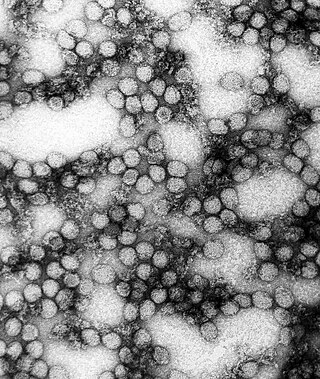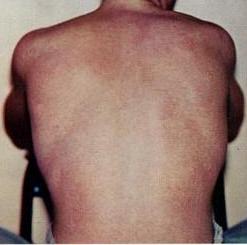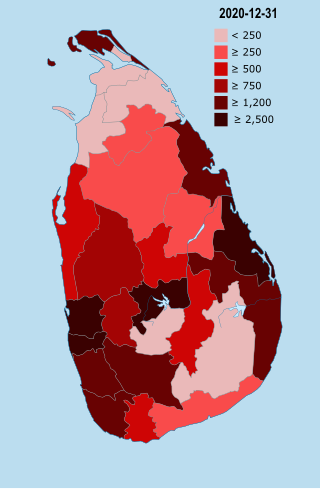
Yellow fever is a viral disease of typically short duration. In most cases, symptoms include fever, chills, loss of appetite, nausea, muscle pains – particularly in the back – and headaches. Symptoms typically improve within five days. In about 15% of people, within a day of improving the fever comes back, abdominal pain occurs, and liver damage begins causing yellow skin. If this occurs, the risk of bleeding and kidney problems is increased.

Dengue fever is a mosquito-borne tropical disease caused by the dengue virus. Symptoms typically begin 3 to 14 days after infection. These may include a high fever, headache, vomiting, muscle and joint pains, and a characteristic skin itching and skin rash. Recovery generally takes two to seven days. In a small proportion of cases, the disease develops into a more severe dengue hemorrhagic fever, resulting in bleeding, low levels of blood platelets and blood plasma leakage, or into dengue shock syndrome, where dangerously low blood pressure occurs.

Chikungunya is an infection caused by the Chikungunya virus (CHIKV). The disease was first identified in 1952 in Tanzania and named based on the Kimakonde words for "to become contorted". Symptoms include fever and joint pain. These typically occur two to twelve days after exposure. Other symptoms may include headache, muscle pain, joint swelling, and a rash. Symptoms usually improve within a week; however, occasionally the joint pain may last for months or years. The risk of death is around 1 in 1,000. The very young, old, and those with other health problems are at risk of more severe disease.

Dengue virus (DENV) is the cause of dengue fever. It is a mosquito-borne, single positive-stranded RNA virus of the family Flaviviridae; genus Flavivirus. Four serotypes of the virus have been found, and a reported fifth has yet to be confirmed, all of which can cause the full spectrum of disease. Nevertheless, scientists' understanding of dengue virus may be simplistic as, rather than distinct antigenic groups, a continuum appears to exist. This same study identified 47 strains of dengue virus. Additionally, coinfection with and lack of rapid tests for Zika virus and chikungunya complicate matters in real-world infections.
In the 2005 dengue outbreak in Singapore, a significant rise in the number of dengue fever cases was reported in Singapore, becoming the country's worst health crisis since the 2003 SARS epidemic. In October 2005, there were signs that the dengue fever outbreak had peaked, as the number of weekly cases had declined and the outbreak of this infectious disease declined by the end of 2005.

Venezuelan equine encephalitis virus is a mosquito-borne viral pathogen that causes Venezuelan equine encephalitis or encephalomyelitis (VEE). VEE can affect all equine species, such as horses, donkeys, and zebras. After infection, equines may suddenly die or show progressive central nervous system disorders. Humans also can contract this disease. Healthy adults who become infected by the virus may experience flu-like symptoms, such as high fevers and headaches. People with weakened immune systems and the young and the elderly can become severely ill or die from this disease.
The 2006 dengue outbreak in Pakistan was at the time the worst on record. There were 1931 lab-confirmed cases, and 41 confirmed deaths, according to the World Health Organization Regional Office for the Eastern Mediterranean. Other sources report a death toll of 52.

Mosquito-borne diseases or mosquito-borne illnesses are diseases caused by bacteria, viruses or parasites transmitted by mosquitoes. Nearly 700 million people get a mosquito-borne illness each year resulting in over 725,000 deaths.

Bangladesh is one of the most populous countries in the world, as well as having one of the fastest growing economies in the world. Consequently, Bangladesh faces challenges and opportunities in regards to public health. A remarkable metamorphosis has unfolded in Bangladesh, encompassing the demographic, health, and nutritional dimensions of its populace.

The 2009 Bolivian dengue fever epidemic was an epidemic of dengue fever which struck Bolivia in early 2009, escalating into a national emergency by February. The BBC described it as the worst outbreak of dengue fever in the country's history. At least 18 people died and 31,000 were infected by the mosquito-transmitted arbovirus.

Zika virus is a member of the virus family Flaviviridae. It is spread by daytime-active Aedes mosquitoes, such as A. aegypti and A. albopictus. Its name comes from the Ziika Forest of Uganda, where the virus was first isolated in 1947. Zika virus shares a genus with the dengue, yellow fever, Japanese encephalitis, and West Nile viruses. Since the 1950s, it has been known to occur within a narrow equatorial belt from Africa to Asia. From 2007 to 2016, the virus spread eastward, across the Pacific Ocean to the Americas, leading to the 2015–2016 Zika virus epidemic.

As of 2010, dengue fever is believed to infect 50 to 100 million people worldwide a year with 1/2 million life-threatening infections. It dramatically increased in frequency between 1960 and 2010, by 30 fold. This increase is believed to be due to a combination of urbanization, population growth, increased international travel, and global warming. The geographical distribution is around the equator with 70% of the total 2.5 billion people living in endemic areas from Asia and the Pacific. Many of the infected people during outbreaks are not virally tested, therefore their infections may also be due to chikungunya, a coinfection of both, or even other similar viruses.
In the 2013 dengue outbreak in Singapore, a significant rise in the number of dengue fever cases was reported in Singapore. The outbreak began in January, with the number of infections beginning to surge in April, before eventually reaching a peak of 842 dengue cases in the week of 16–22 June 2013. This figure was far beyond the highest number of cases per week in the previous three years. Although there were concerns that the rate of infection could exceed 1,000 per week, these fears did not materialize.

The 2007 Yap Islands Zika virus outbreak represented the first time Zika virus had been detected outside Africa and Asia. It occurred in the Yap Islands, an island chain in the Federated States of Micronesia. Zika virus (ZIKV) is a vector-borne flavivirus in the same family as yellow fever, dengue, West Nile and Japanese encephalitis viruses.
In October 2013, there was an outbreak of Zika fever in French Polynesia, the first outbreak of several Zika outbreaks across Oceania. With 8,723 cases reported, it was the largest outbreak of Zika fever before the outbreak in the Americas that began in April 2015. An earlier outbreak occurred on Yap Island in the Federated States of Micronesia in 2007, but it is thought that the 2013–2014 outbreak involved an independent introduction of the Zika virus from Southeast Asia. Investigators suggested that the outbreaks of mosquito-borne diseases in the Pacific from 2012 to 2014 were "the early stages of a wave that will continue for several years", particularly because of their vulnerability to infectious diseases stemming from isolation and immunologically naive populations.

The 2019 dengue outbreak in Bangladesh is a nationwide occurrence of dengue fever in Bangladesh that began primarily in April 2019 and is still ongoing. According to Directorate General of Health Services (DGHS), 14 people have died and 19,513 people have been affected as of 1 August 2019, majority of whom are children. Although other sources are reporting the death toll has already passed 50. On 1 August 2019, DGHS confirmed the outbreak affecting all districts of the country. Additionally, it reported 1,712 newly infected patients in the preceding 24 hours which is also the largest number of infected people on record in a single day. According to official source, roughly 71 more people are being infected in dengue fever every hour. Dhaka is the worst-hit city in the country and the districts in Dhaka Division are among the most affected regions. Experts feared that the situation would deteriorate as a lot of people traveled from major cities to rural areas to celebrate Eid al-Adha holidays in August. The Institute of Epidemiology, Disease Control and Research (IEDCR) expects the outbreak to continue till September 2019.

The 2019–2020 dengue fever epidemic was an epidemic of the infectious disease dengue fever in several countries of Southeast Asia, including the Philippines, Malaysia, Vietnam, and Bangladesh, Pakistan, India, Thailand, Singapore, and Laos. The spread of the disease was exacerbated by falling vaccination levels in certain areas, and by a growing population of mosquitoes, which are the primary carriers of the disease, and which are able to reproduce in larger numbers where humans have littered the environment with plastic containers, which provide an ideal breeding ground for mosquitoes. Affected countries have sought to control the epidemic through increased vaccination efforts, and through efforts to control the mosquito population.

The dengue pandemic in Sri Lanka is part of the tropical disease dengue fever pandemic. Dengue fever is caused by Dengue virus, first recorded in the 1960s. It is not a native disease in this island. Present-day dengue has become a major public health problem. Aedes aegypti and Aedes albopictus are both mosquito species native to Sri Lanka. However, the disease did not emerge until the early 1960s. Dengue was first serologically confirmed in the country in 1962. A Chikungunya outbreak followed in 1965. In the early 1970s two type of dengue dominated in Sri Lanka: DENV-1 type1 and DENV-2 type 2. A total of 51 cases and 15 deaths were reported in 1965–1968. From 1989 onward, dengue fever has become endemic in Sri Lanka.

In the 2017 dengue epidemic in Sri Lanka, a rise in the number of dengue fever cases was reported on the island country of Sri Lanka. The peak of the outbreak was in the mid-year monsoon rain season, when there was record of over 40,000 cases in July. This figure was far beyond the historical highest number of cases per month in Sri Lanka. Year end total dengue cases rose to 186,101.
In the 2020 dengue outbreak in Singapore, a record-breaking number of dengue fever cases was reported in Singapore. This was part of the wider 2019–2020 dengue fever epidemic which also affected several neighbouring countries in Southeast Asia.














